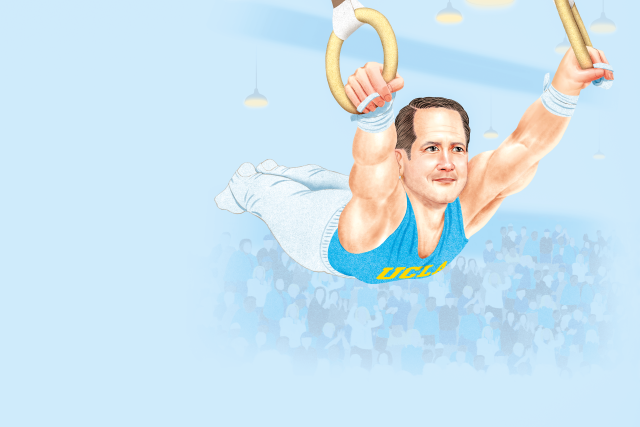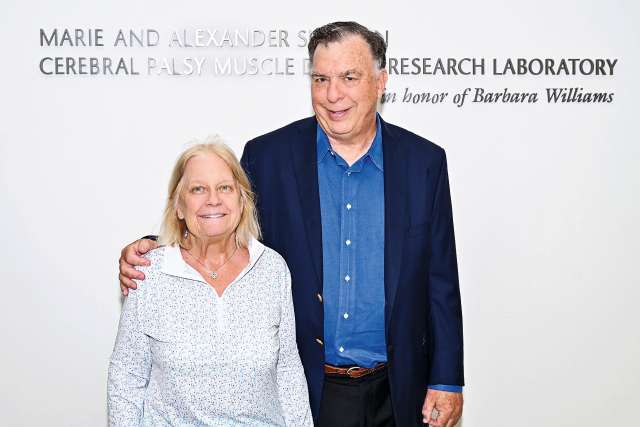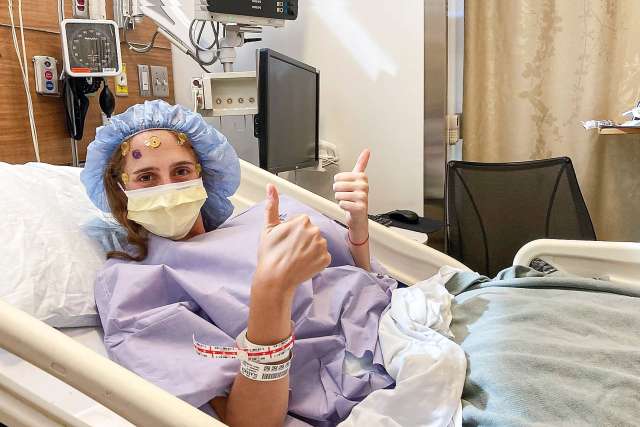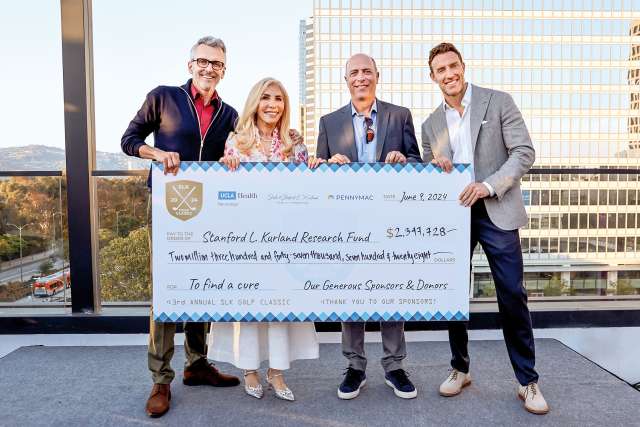STEPS INTO THE U MAGAZINE SPOTLIGHT
When Robert Prins, PhD (FEL ’02), came to UCLA as an undergraduate in the 1980s, his goal was to become the next world’s-greatest gymnast. That didn’t work out as he’d hoped, so Dr. Prins moved on to an alternate plan, pursuing a career in science. Today, as a professor of neurosurgery and molecular and medical pharmacology, he and his lab group are working to understand why some brain tumors are resistant to immune-based therapies that have proven to be effective against other cancers, and how to overcome those barriers to treat patients more effectively.
When did you first start to think about science?
It was pretty early on. My dad was, I think, a bit of a frustrated scientist. He wanted to be a physician-scientist, but he ended up mostly as a private-practice OB/GYN. He had lots of colleagues in the research field, and so it was something that was always around. Through one of his colleagues, I worked during high school at the Oregon National Primate Research Center, where Dr. Linda Bradley was doing the early immunology studies on HIV. I continued to correspond with her when I was in college. Science is something I’ve been around most of my life.
What has been your greatest challenge in your work?
Trying to understand the impediments to inducing immune responses to tumors in the brain. They’re very immune-suppressive. You can give the same type of immunotherapy to a patient with melanoma or with lung cancer and it works really well. But it just doesn’t do the same thing for patients with a brain tumor. Trying to understand why that is has occupied my time for a good 10 years.
Where does your inspiration come from?
From my wife, Dr. Mayumi Prins (PhD ’97, FEL ’98), who is director of the Brain Injury Research Center. She is one of those people who loves being in the lab, who loves science. That is inspiring for me. And from my dad. He really did want to be a physician-scientist, and even though he didn’t get to do that, he fostered that desire in me.
Who is your science hero?
Ralph Steinman. He discovered the dendritic cell while at Rockefeller University in New York, for which he won, posthumously, the Nobel Prize in Physiology or Medicine in 2011. I got to sit next to him during a National Institutes of Health study section. He had pancreatic cancer, but he still had a glimmer in his eyes, and he was very nice and asked great questions.
Where are you happiest?
My family has a place in the San Juan Islands in the Pacific Northwest, and we often go there for vacations — and any other time we can manage it. I fish. I cut wood. I get away from cell phones.
What do you consider to be your finest achievement?
Hopefully I haven’t had it yet. I’m proud of the work we’ve done and the strides we’ve made to induce immune response to brain tumors, but we’re hopeful there is more to come.
What characteristic most defines you?
Perseverance, I think. Things don’t always work out the way you hope they will, so you have to be persistent and try to understand why it didn’t work, how to get over the hurdle so that you can move forward. Having been a gymnast was very good training. You have to learn how to lose and to fall and to get back up. Science is very much like that.
What is your greatest virtue?
I am collaborative. I am very proud that we’ve built this really collegial group of clinical and research faculty and students who all get along and who want to support each other, which enables us to study things in greater depth. It’s different from the old days, when everyone was siloed in their lab doing their own thing. Collaboration has been one of the things I’m most proud of.
What is your greatest fault?
Sometimes I’m too nice.
When do you not think about science?
When we are on Lopez Island. I try to go up there and do birdwatching, go fishing, chop some wood and think about other things.
If not a scientist, what would you be?
A gymnast. That is why I came to UCLA as an undergrad. I could have gone to several other schools on a full scholarship, but UCLA was just the best. I was good, but when you get to a place like UCLA, where the athletes and the drive are at the next level, you really learn to appreciate the work ethic, as well as the talent. I was not in the same league as some of those guys who went on to the Olympics. So, I didn’t become an Olympic gymnast, but it was a time that made me learn how to work hard.
What is your most treasured possession?
Time with family, friends and colleagues. Enjoying a good single-malt together with colleagues fosters good science.
What are you most compulsive about?
My email. I can’t go to sleep at night until I’ve closed out my inbox.
What’s the best moment in your day?
Early morning. I get up at 5:00 and go for a run. I usually try to think about some of the science that we’re going to do that day in the lab, and then I try to write and do my reading early, before I get another hundred emails. Those early-morning hours are the most precious.
What is your definition of happiness?
Working at the thing that you really enjoy. That is what is so great about being at an academic institution — you can work on whatever is your passion.
What is your definition of misery?
Finances. Ugh! I love doing the science, but I don’t like having to deal with budgets.
What book has inspired you?
7 Kinds of Smart. It talks about people who are successful in the world, and they’re not always the ones with intellectual smarts. The author came up with seven different pathways to being smart — verbal, logical, spatial, musical, touch/kinesthetics, interpersonal and intrapersonal. I think one of the things that has made our lab group successful is having not only lots of really bright people, but also people who have a high emotional quotient and who can get along and collaborate. That book reminds me that there is a smarts to getting along with people. In the world of science, that can be very helpful.



